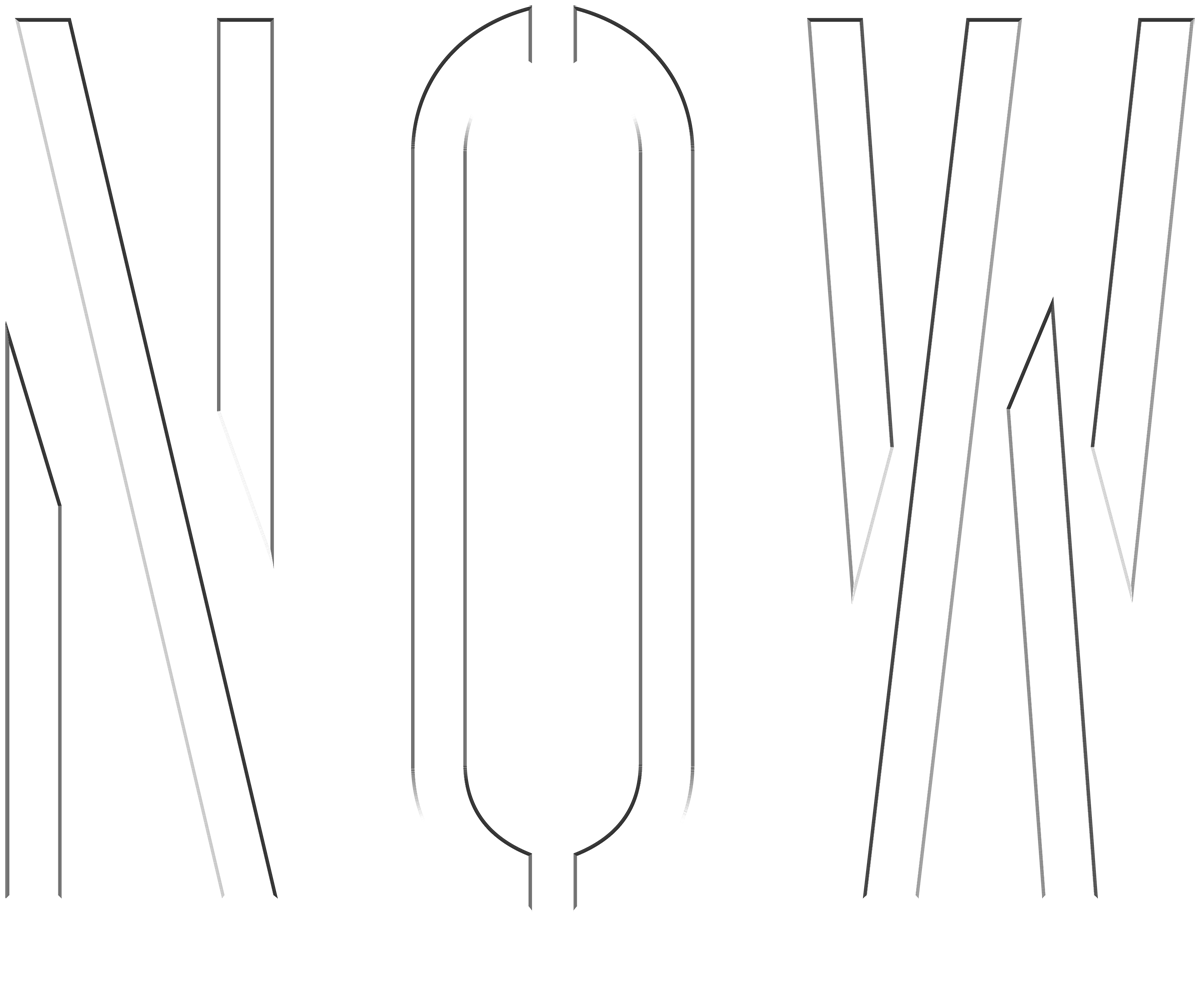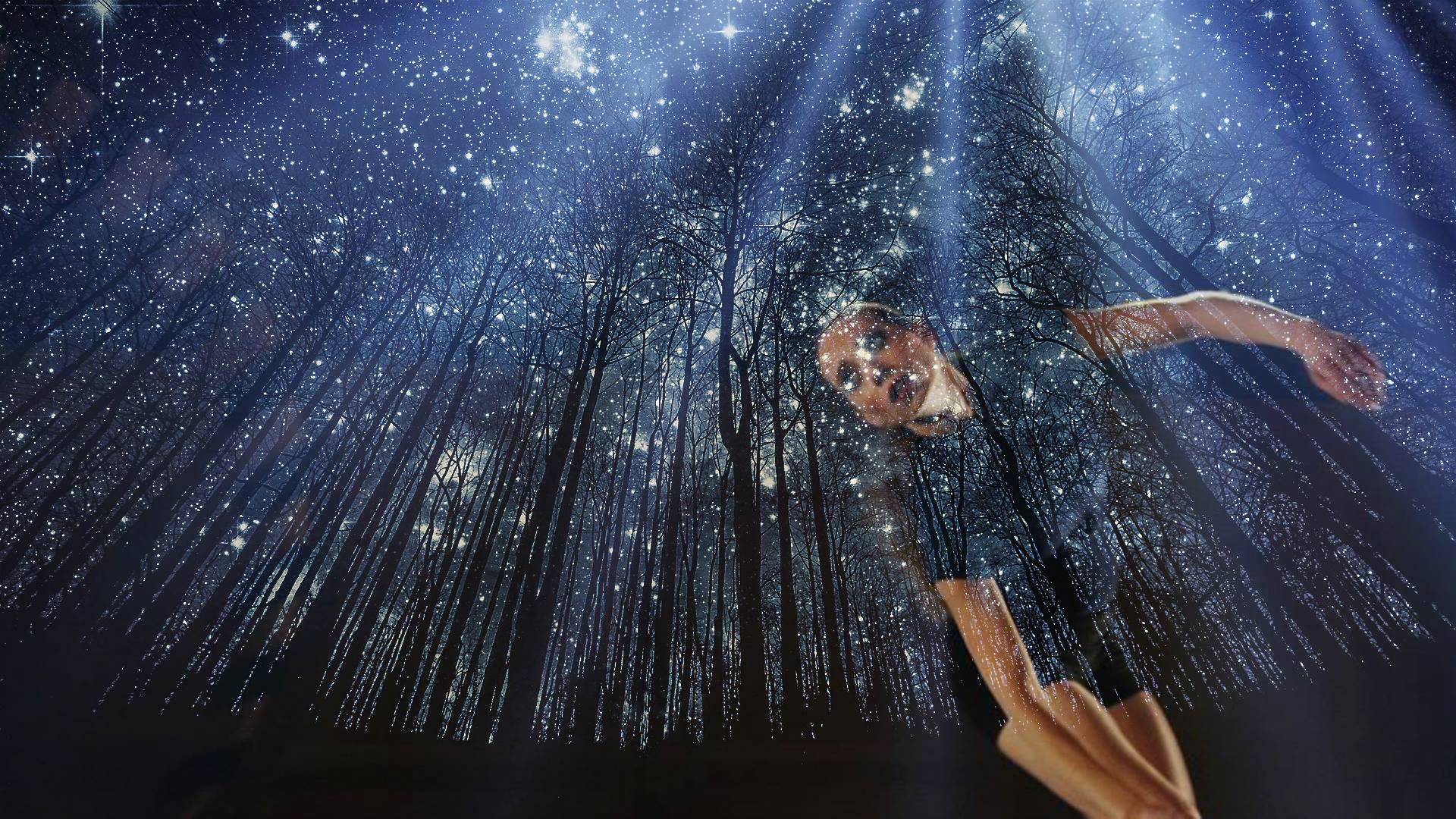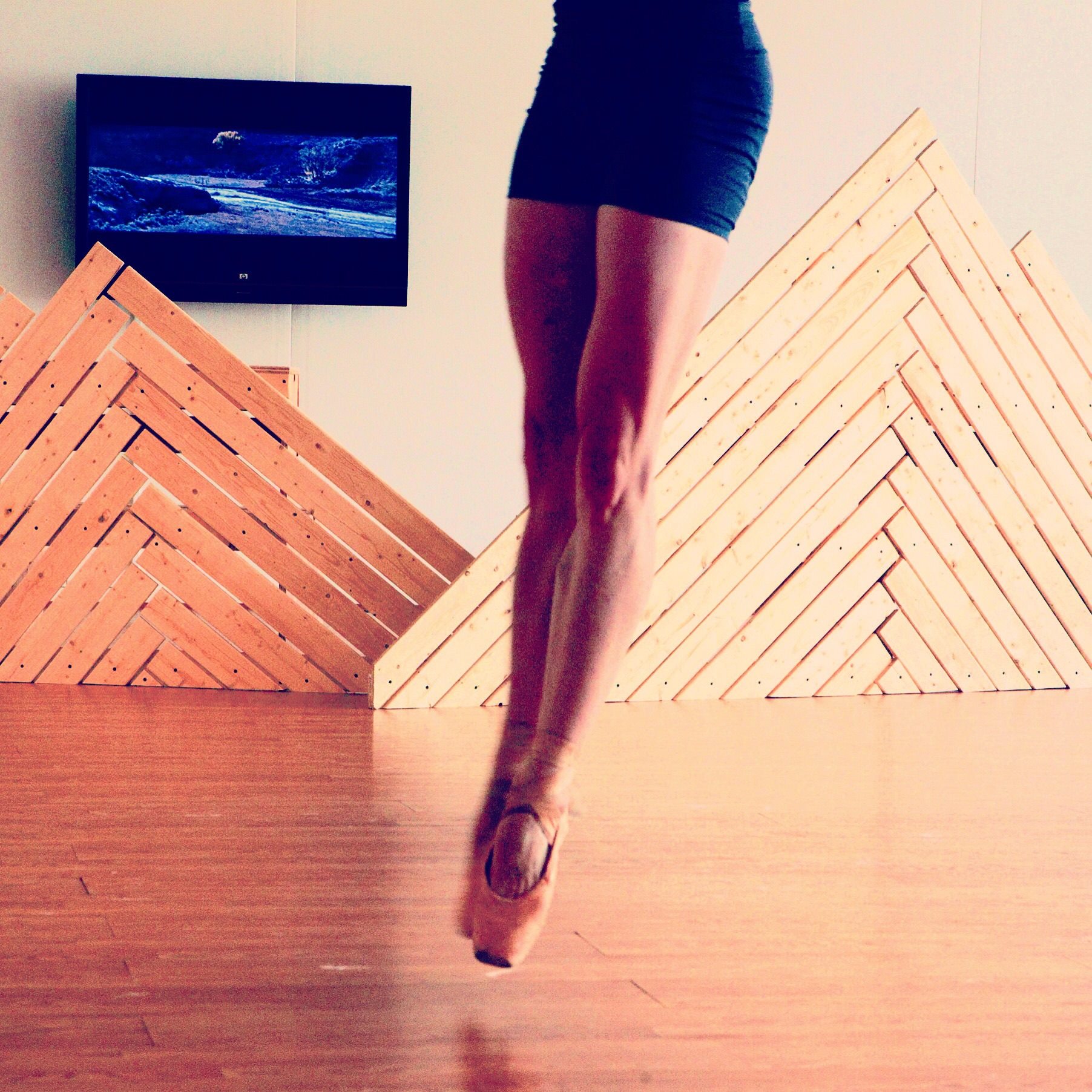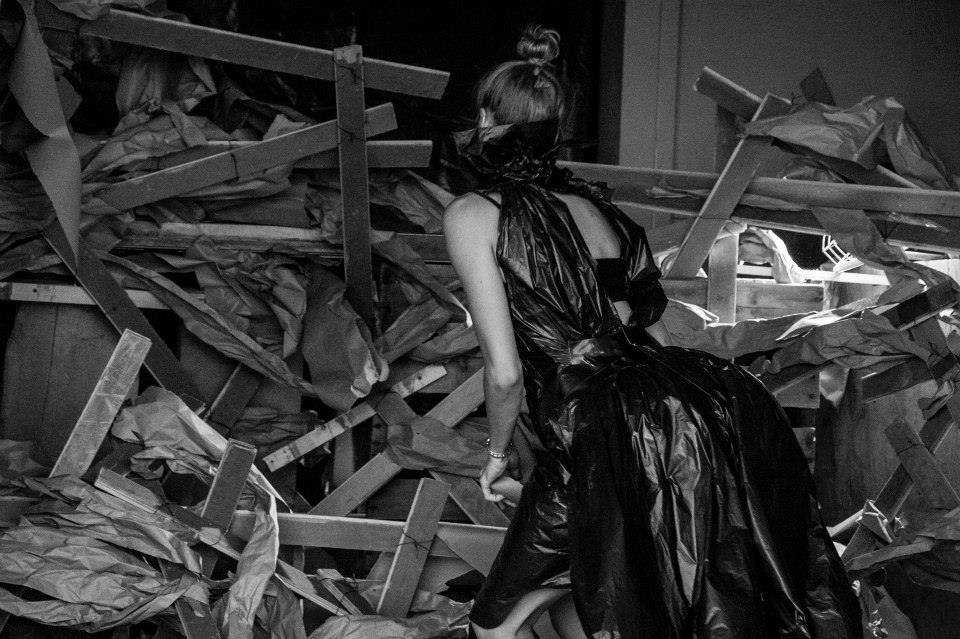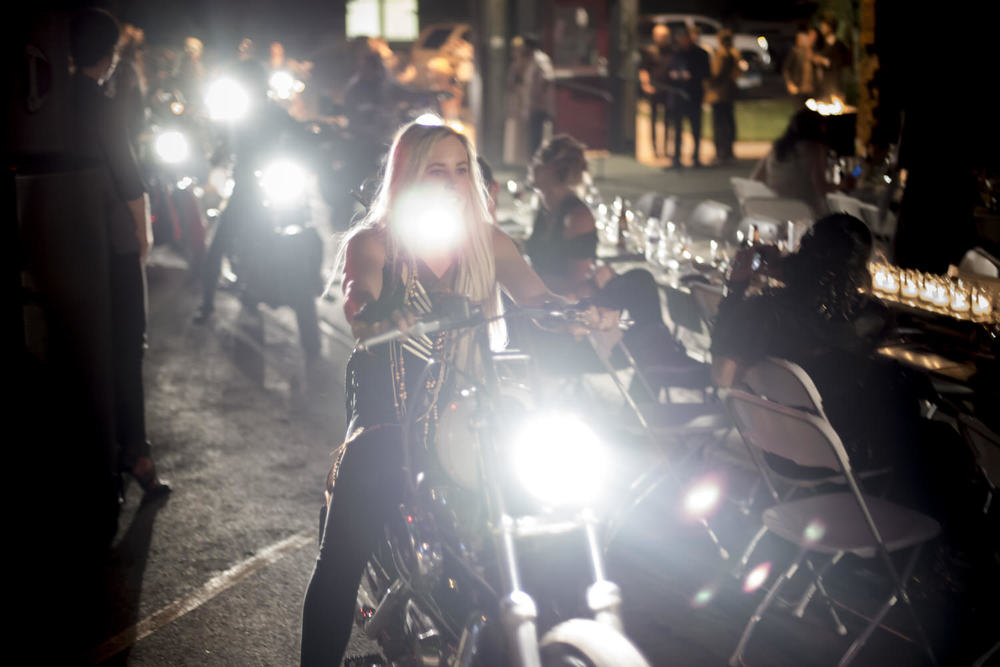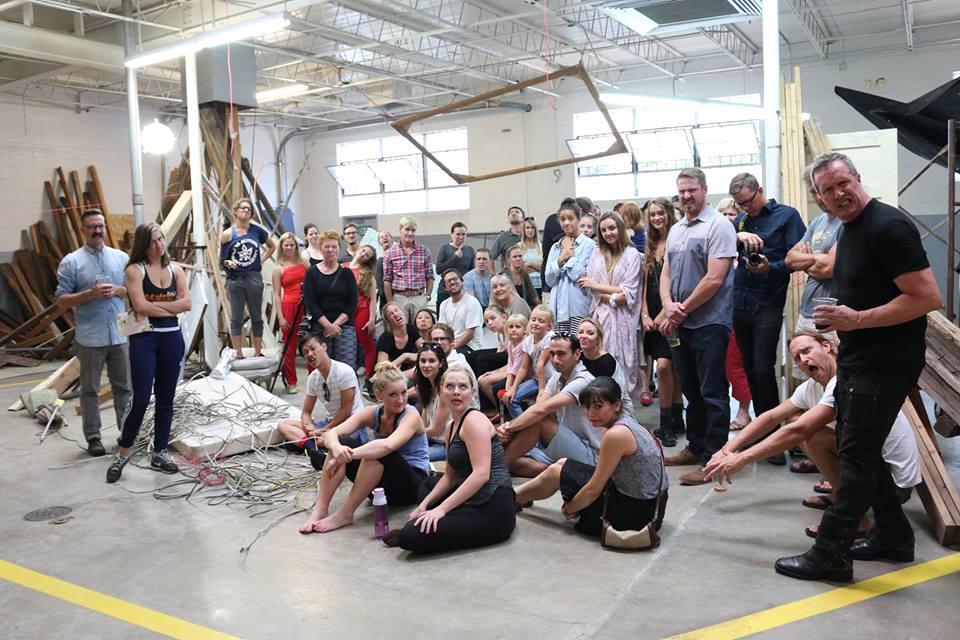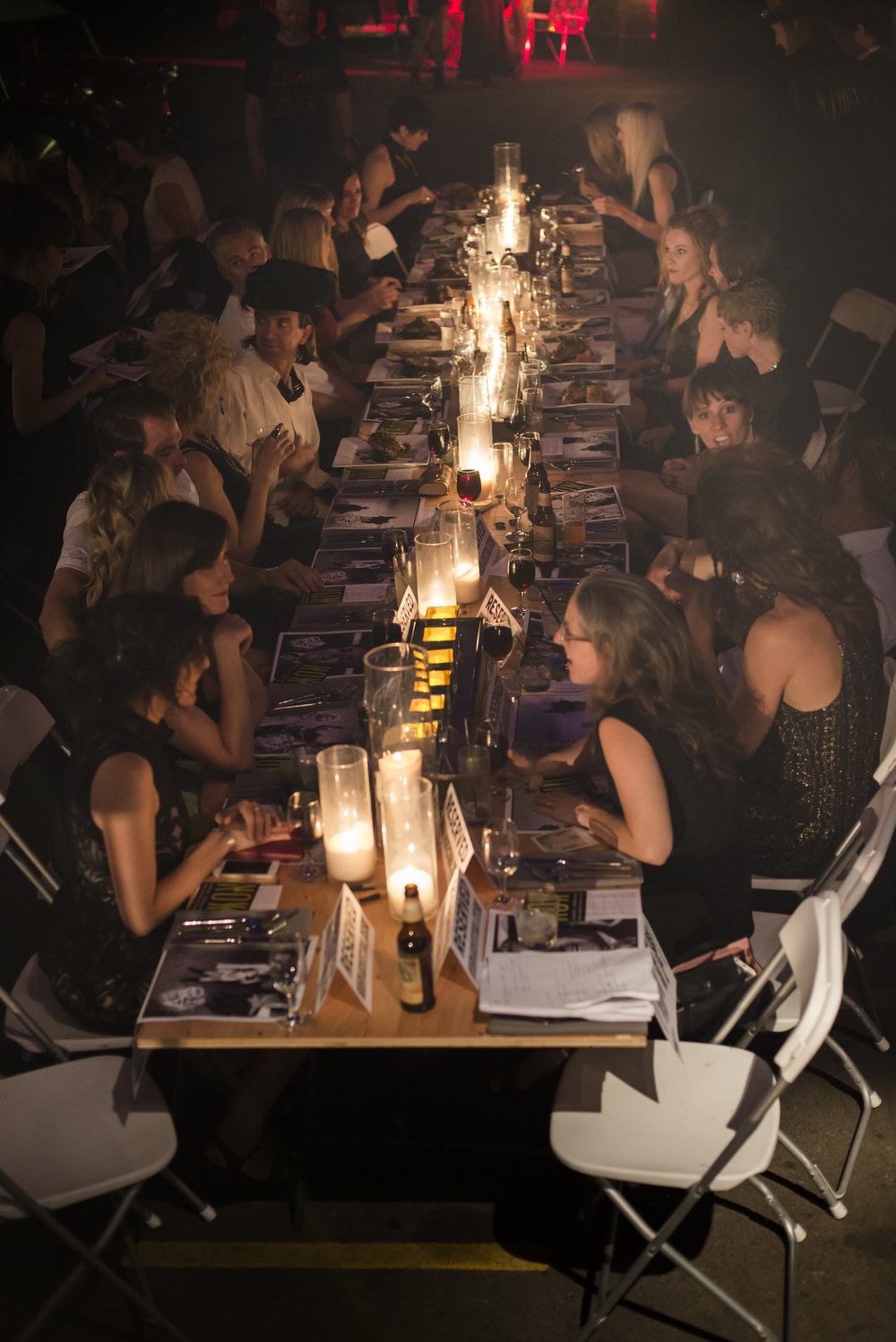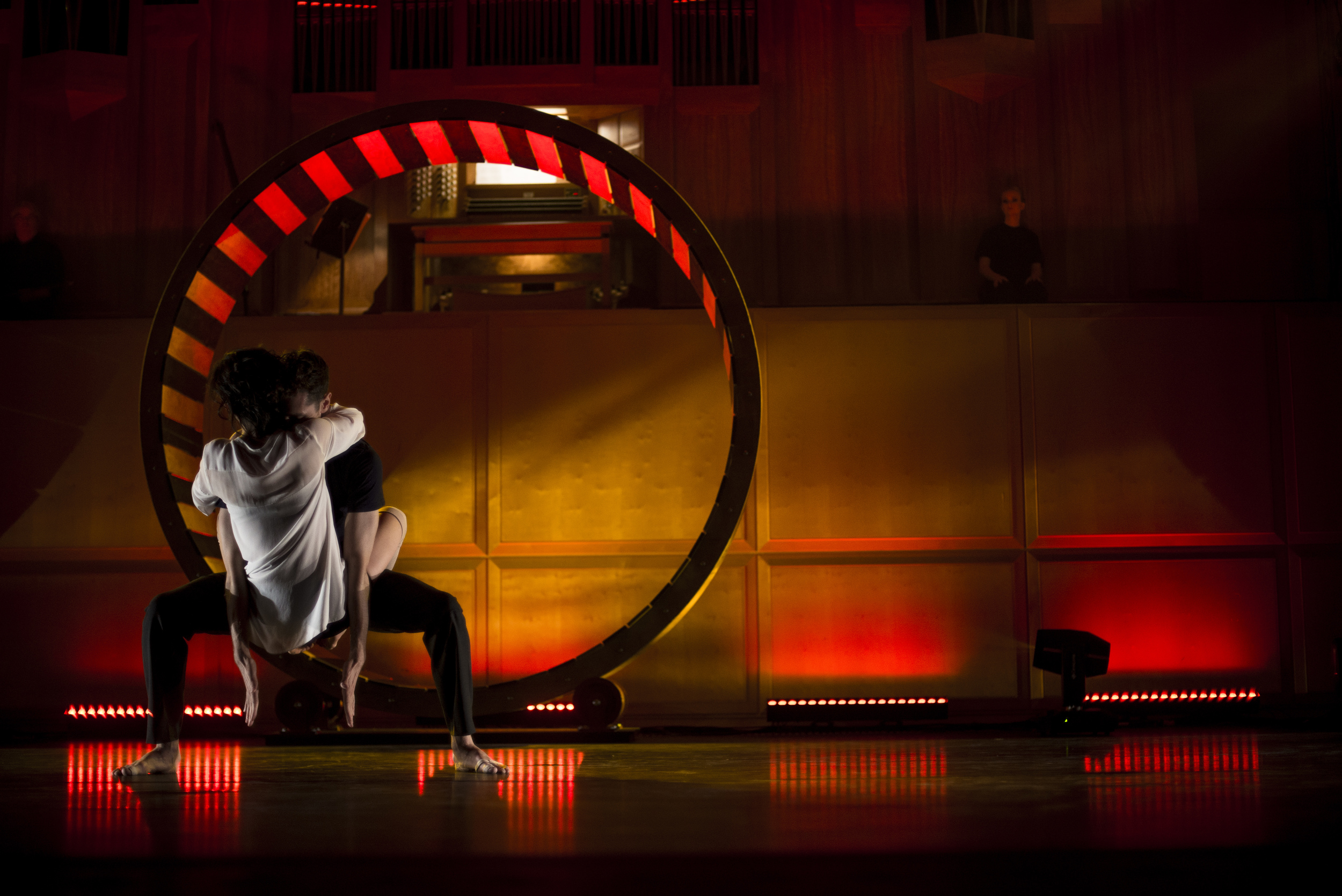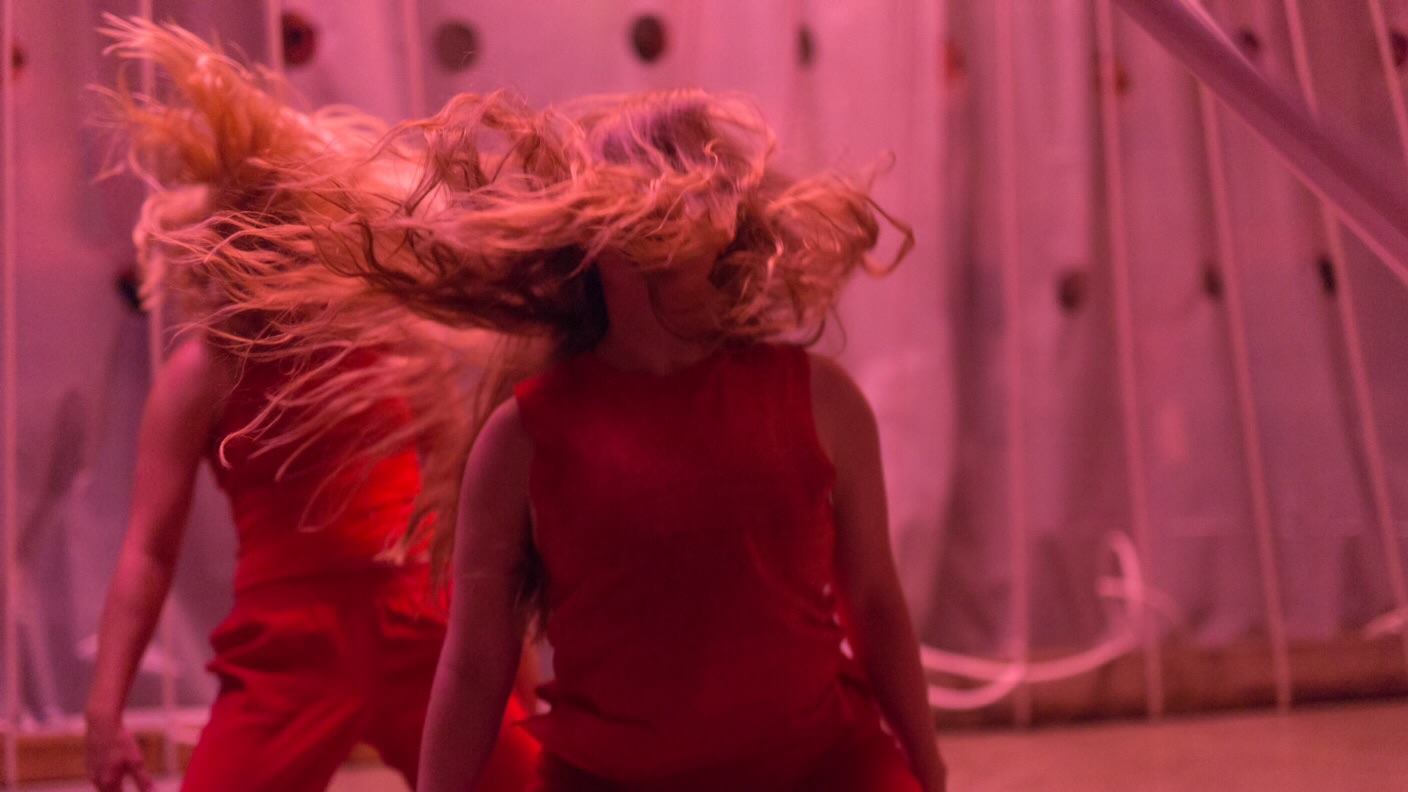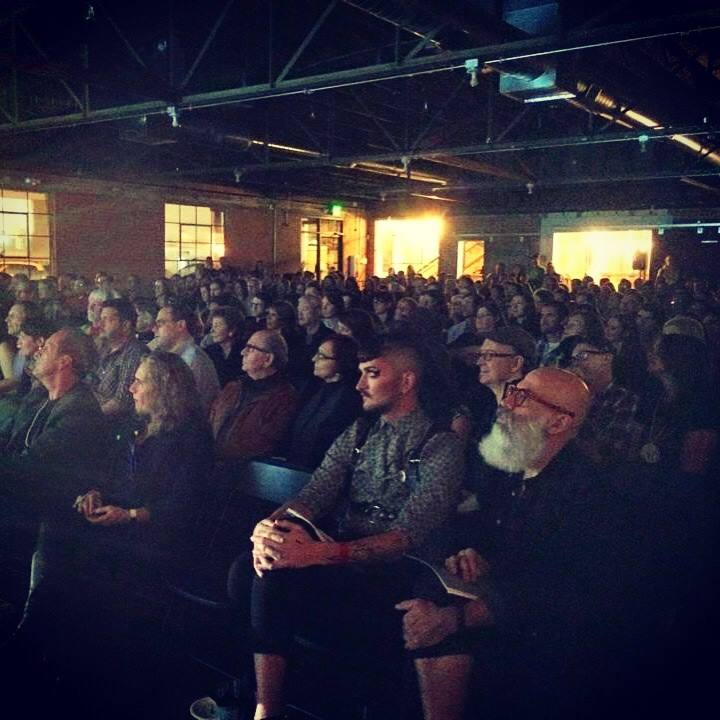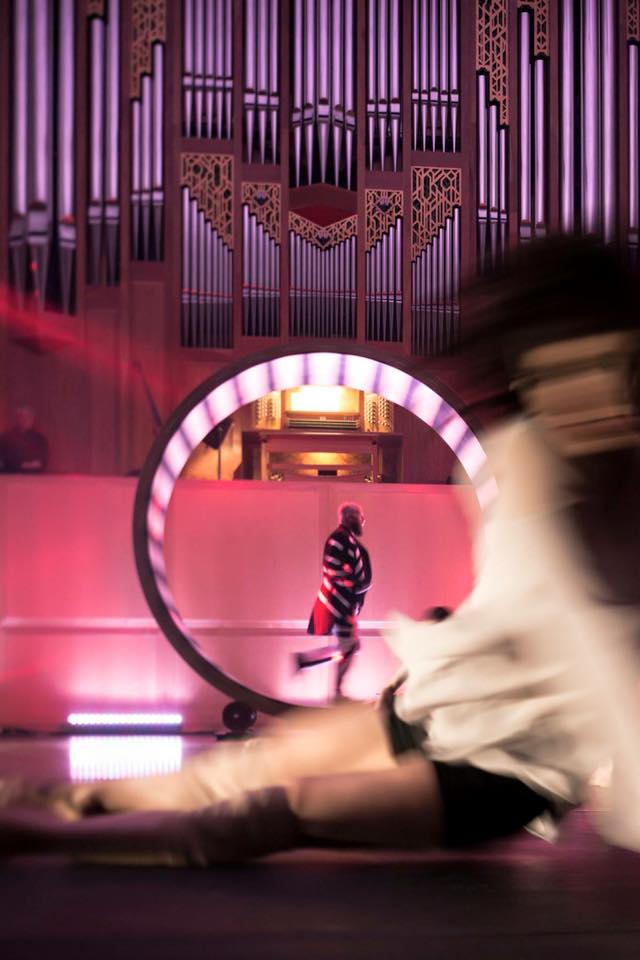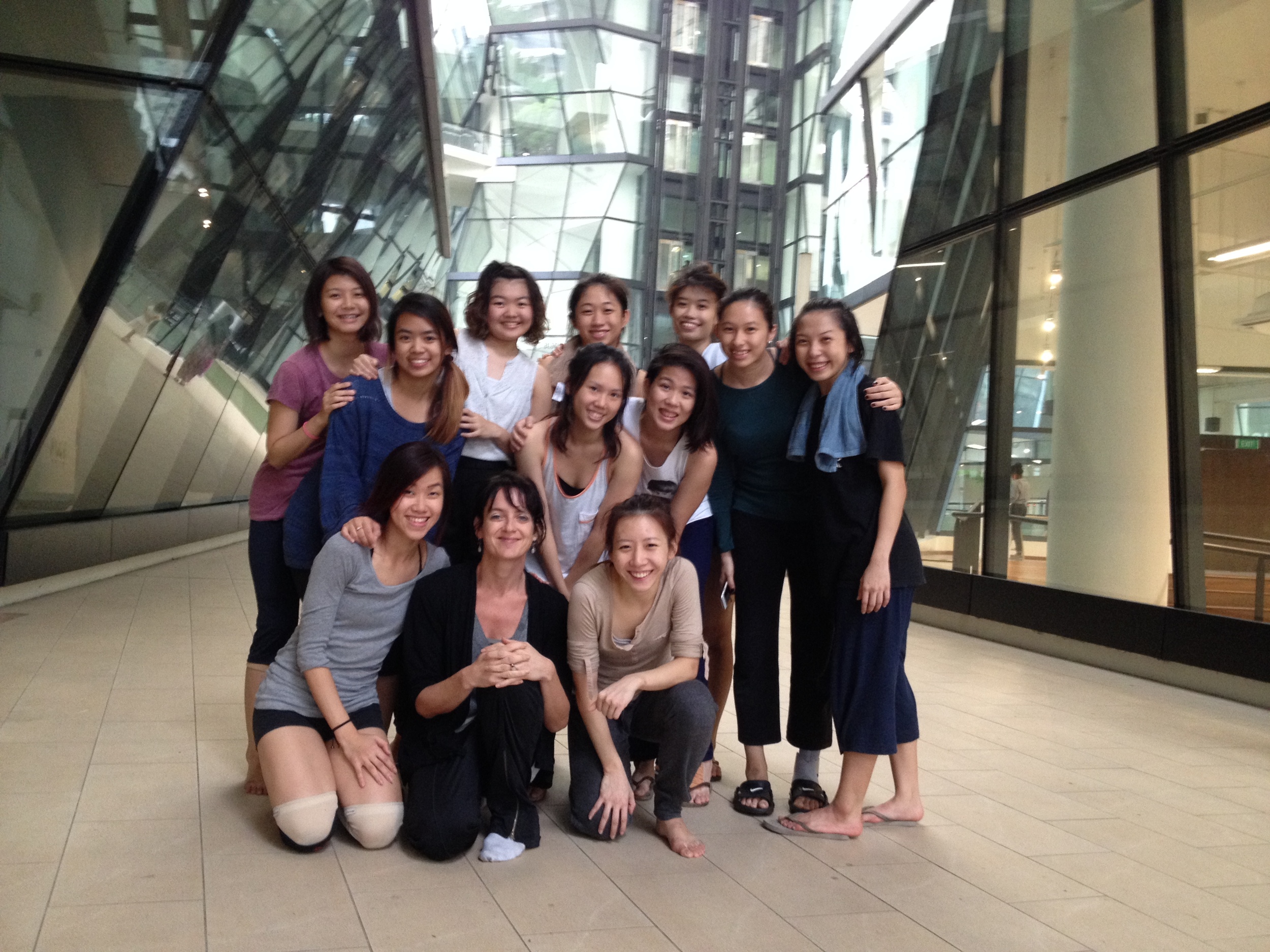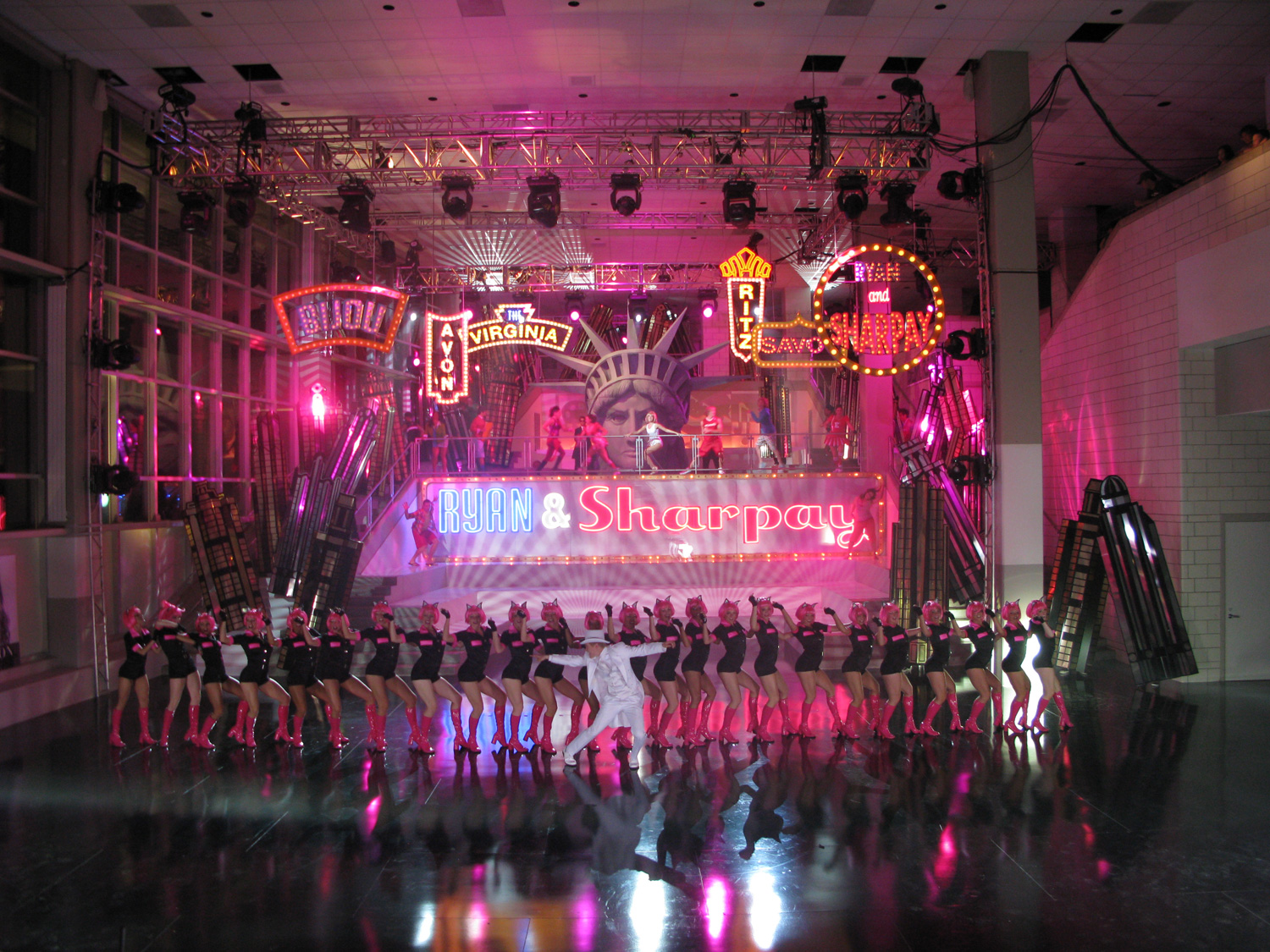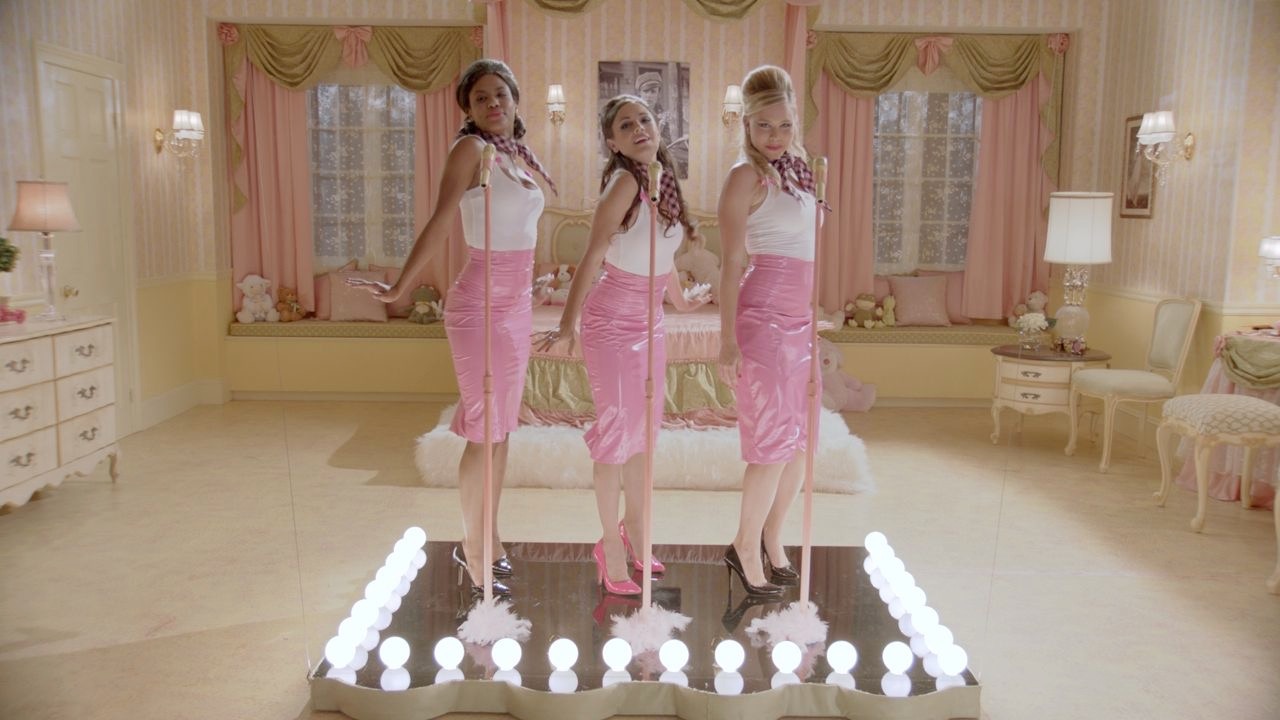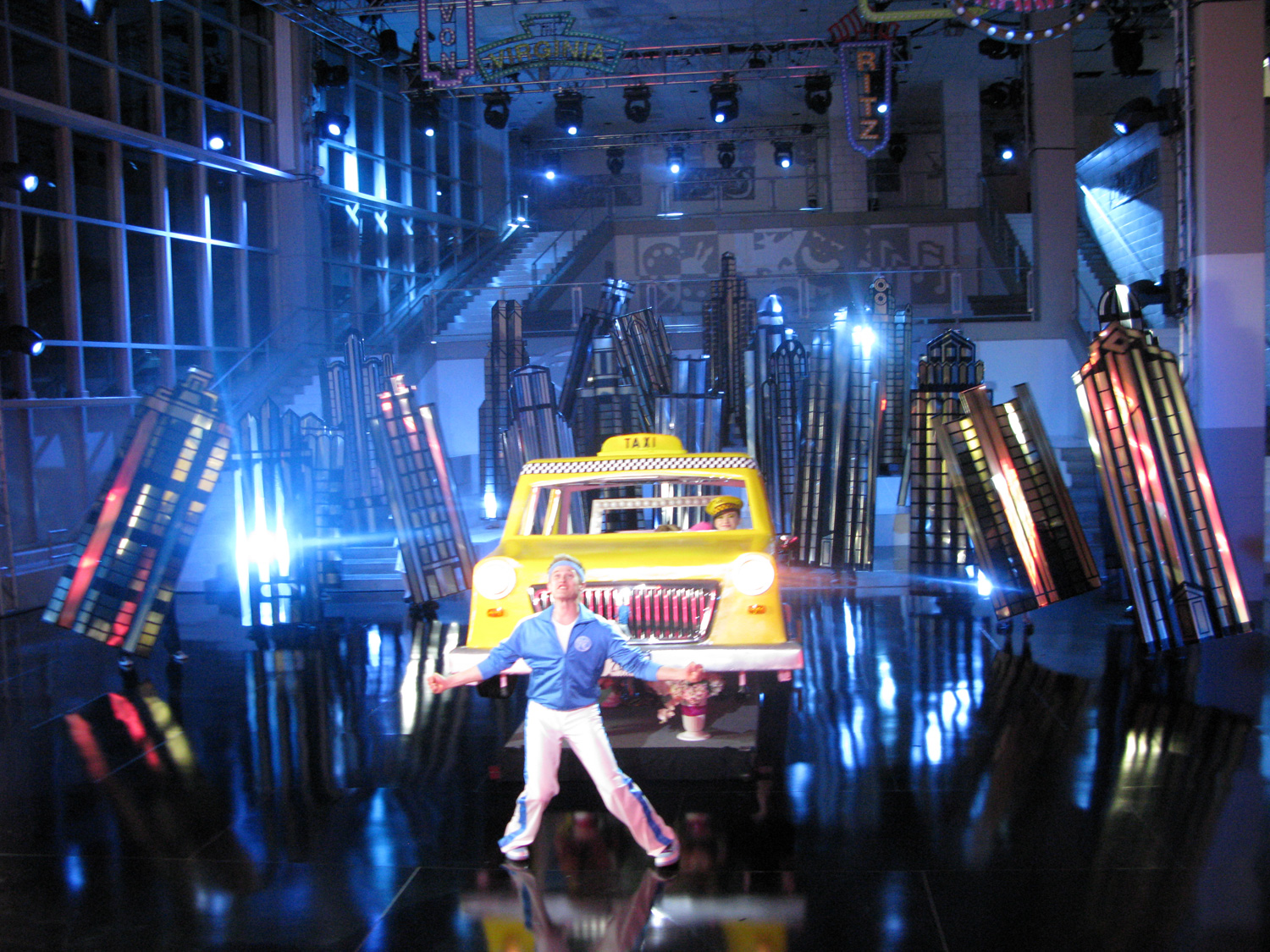RSVP to Elpitha@gmail.com
NE PLUS ULTRA: ACTOR ETHAN PHILLIPS /
Ethan Phillips is an actor who grew up in Garden City, NY. He received a Bachelor of Arts from Boston University and later an MFA from Cornell University. He has had a prolific career in television, movies and on stage working with such directors as Milos Forman, Woody Allen, the Coen Brothers and actors Nathan Lane, Bryan Cranston and more. He played the role of "Neelix" on Star Trek: Voyager for seven seasons and was a member of "The Sundance Playwrights' Conference" for six summers. And this is just a fraction of his wide reaching work.
Nathan and I met Ethan four and half years ago when he was introduced to us through writer David Kranes. I immediately fell in love with his quick wit, intuitive brilliance and endless generosity as an artist and human being. We ended up doing a project together titled "But Seriously" and I hope to collaborate again in the future.
Enjoy!
Charlotte Boye-Christensen
Tell us a little bit about your background; when did you know that you wanted to become an actor?
As a young boy watching a television show with my mother and sisters. The show was a short-lived series in the 50s called PANIC. On screen was a terrible accident about to happen: a car with a family inside was rolling towards a cliff where certain destruction waited - I was very upset and very frightened until my mother patiently explained to me that the people in the car were ‘actors’ and they were only pretending. That they were on a TV ‘set.’ In fact, she told me, these ‘actors’ would probably have a coffee break and then do the same scene again. I calmed down. At that early age I understood what she was saying. And it amazed me that grown ups did that for their job. While in High School, auditioning for a role in the school play, the director, a Jesuit priest, told me I was very good at it. In college I met people who wanted to do it for a living; I decided I could too. But ultimately like all actors I just had an urge to appear private in public.
What do you consider to be your breakthrough role and why?
The role of the painter Maurice Utrillo in Dennis McIntyre’s 1980’s off Broadway hit MODIGLIANNI at New York’s legendary Astor Place Theatre. Utrillo was a drunken emotional mess living on the edge of poverty with an immense need to express himself through his craft – painting. I was in a similar place (though by no means would I compare my skills to Utrillo, a great under-sung artist). Except instead of being in Paris in 1920, I was in Manhattan in 1980. I had the same needs he did except my craft was acting. I was able to use myself in a role in a way I hadn’t done before. Actors don’t run from themselves – they run to themselves. The show was a massive hit. I experienced acknowledgement as a professional for the first time.
What was your most difficult role?
Edgar in King Lear.
You have worked with such a diverse group of directors from the Coen brothers to Woody Allen, do you prefer to work with directors who are very specific about what they want or do you prefer to be left alone to discover who your character is?
Any suggestions or ideas are welcome. I like to work with directors who provide a safe environment, a place to be creative and make mistakes. A director needs to be your biggest fan. In TV work though, if you see the director coming your way after a scene, look out – you don’t want that. All you want is to hear ”got it, moving on.’
Can you tell us a little bit about your creative process - how do you prepare for a role? Does intuition play a role in your process? And what are the differences in performing on stage and on TV/Film? Which medium do you prefer and why?
It depends on the medium in some ways. I find in television and film they basically want me, who I am as a package. How I sound, how I look. How I present: a small, bald, somewhat benign man – where the camera can sweep over me and the viewers can feel free to make their generalizations about the role. Theatre can give you more room to build a character who may be different from whom you immediately present as yourself. I like what David Mamet says: to paraphrase, ‘there is no character, just the actor; my aunt Betsy is a character.’ As for preparing for a role, it’s a self-hypnotic exercise – you convince yourself you can pretend well enough to get people to suspend their disbelief. In her new novel A Little Life, Hanya Yanagihara calls acting ‘… a form of grifting, and once you stopped believing you can, so does everyone else.’
I prefer stage because of it’s immediacy and the power, though I like film and TV because I don’t get as nervous.
And my first instincts are often my best.
Tell us a little bit about the highlights of your career so far?
The three times I’ve been on Broadway – Mamet’s NOVEMBER, Robert Schenkkan’s ALL THE WAY, and the musicalMY FAVORITE YEAR, are special because when you are on Broadway you are king. Going to that Broadway house each night, up to your dressing room, to perform on the Great White Way – nothing can beat the feeling. And working with Woody Allen. To be an actor and see your name in the credits with that font he uses – wow.
Without naming names what was the worst experience you have had as an actor?
I did a production of a play which toured the Summer Stock circuit; there was an actor who was selfish and addicted to drugs. It was awful. There have been other productions with divas, and rarely but once or twice directors who were bullies. I did a TV pilot this year which required five hours of makeup and a two hour removal. When asked to do the series, I said no. I’d rather mainline bleach. But 99% of the time I have a blast!
Who are some of the people who have inspired you in your work and why?
Because of their ability to be flawless, in no particular order, Helen Mirren, Judi Dench, Marlon Brando, Kate Winslett, Jean-Louis Trintignant, Barbara Stanwyck, Richard Widmark, Gérard Depardieu, Isabelle Huppert, Anthony Hopkins, Lee J. Cobb, Peter Sellers, Vanessa Redgrave, Mark Rylance, and many others.
What is your favorite movie?
Two: A Christmas Carol with Alastair Sim, and The Exorcist.
What do you consider to be the most significant film ever made?
Les Enfants du Paradis (Children of Paradise)
Do you think that there is more creativity in television nowadays than perhaps 20 years ago and if so, why do you think that is?
Much more. Due to long format continuity of plot. Plus because the money is better, it has attracted huge talent.
How do you problem solve and have you ever experienced a creative block and if so how did you get through it?
The main question I always ask is: why am I still in the scene? Why am I still in the room? What do I want?
I have experienced creative block. It usually is because I am doing too much. Or maybe the writing sucks. Sometimes picking up the pace helps. Sometimes taking your time helps. Often the answer is listening to the other actor.
What is your favorite quote?
Be kind, for everyone is fighting a great battle. (Plato)
You have such amazing comedic timing yet you also manage to take on dramatic roles, what do you prefer?
Thank you for that compliment!! I like any role, which is well written. Or which pays.
What do you think are the three most important features that an artistically successful actor has?
You need three things to make it: Talent, Tenacity, and Luck. Without all three, you will fail.
Tell us a little bit about what Star Trek did for your career and what inspired you to start collecting jokes?
Star Trek gave me the financial freedom to do more theatre.
I’ve been collecting jokes since I was a young boy. My great uncle was a vaudeville comic and I adored him. Some kids get into magic; for me, the rabbit coming out of the hat was the punch line. And making people laugh gets me high.
You came to Utah to work at the Sundance Playwright’s Lab for six summers and I read somewhere that you helped develop “Angels of America” – how did you initially get involved with the Lab and what do you think that Sundance provided for such significant work to emerge? Also, along those lines can you tell us a little bit about “First Stage” - the playwright’s Lab that you help found in LA?
I got into Sundance by a fluke. I was in LA and one of the Sundance dramaturges wanted to hear a cold reading of an obscure and complicated Ionesco play. I was asked to read the lead role by a friend who was helping cast this reading. It just so happened I’d done the play a few years before, in regional theatre. I didn’t tell the dramaturges that and my ‘cold’ reading was of course very well informed and realized. He thought I’d done the reading having seen the play for the first time and was so was very impressed and said ‘we could use you at Sundance’ and so I was invited. To this day I’ve never let on about my fib.
Sundance was simply a collection of very generous people who believed if it’s not worth doing right, it’s not worth doing. And with our artistic director, David Kranes, we had the most compassionate, enthusiastic, and theatrically astute man anyone could want in charge.
First Stage was based on the format of Sundance. New works are given a reading. The playwright finds that invaluable.
Who is the director (dead or alive) that you have always wanted to work with?
Top of the list is Stanley Kubrick. Martin Scorsese. Alfred Hitchcock. Kenneth Branagh, Pam McKinnon, Jose Quintero.
What is the project that you have always wanted to do?
MacBeth. But I’m too small. And now too old.
If you hadn't become an actor what profession do you think you would have excelled in/at?
I’d have liked to teach Latin.
Looking towards the future – where do you want to be and what do you want to be doing in 25 years?
Alive and in New York City.
What a year! /
Dear friends of NOW-ID, Happy Holidays!
Thank you for all you've given in the past year. Your support has built a container for us to create some amazing work that we feel very proud of. Thank you for your financial support, your attention, attendance, and your appreciation of what we make. We wish you the coziest of holiday seasons filled with beauty, great food, and wonderful people.
As we approach the new year we're looking both forward to what's coming up, as well as back to all the great work we got out in the world.
IN 2015, WE:
- Curated and hosted the Feb. 2015 Pecha Kucha in Salt Lake City - showcased the work of 13 different local and national artists/designers/event planners and had 380 attendees.
- Created two interdisciplinary contemporary dance productions in July titled NOW HERE at the Kimball Art Center in Park City followed by NOWHERE at Libby Gardner Concert Hall. For the latter we gathered 21 local, national and international artists for two nights in July. We had 420 audience members and got amazing reviews and a local Arty in Salt Lake City for best Choreography for this piece that investigated the idea of place. We are now working on touring the show next year.
- Launched our first Summer Workshop in August directed towards designers, dancers and choreographers. In five days we managed to produce 11 pieces by 24 artists and had three showings for the public. Participants came from Portland, Chicago, Allentown, Wichita, NYC, San Diego, Vancouver and of course Salt Lake City, Ogden, Cedar City and Orem. Amazing creativity emerged and our intention is to build on this in 2016.
- Had our first fundraiser, House of Apocalypse, at Addictive Behavior Motor Works. Selected performances by Bad Kids Collective, Cornered by Zombies and the Litas. 210 attendees.
- Worked with more than 236 students at residencies in Miami, Singapore, Mexico, Richmond (Virginia), Ephraim and at Tanner Dance in SLC.
- Collaborated with local arts organizations: Kimball Art Center in Park City, Tanner Dance, SLAC, The Multi-disciplinary Design Program at the Department of Architecture at the University of Utah, Adam Bateman from CUAC and UMOCA in SLC.
- We started a monthly artist/designer profile on our blog. Upcoming interviews will feature local Designer Andrea Beecher, NYC-based Actor Ethan Phillips and British Choreographer Wayne Mcgregor.
- We welcomed Elpitha Tsoutsounakis onto the Board. She is an assistant professor and founding faculty member of the Multi-disciplinary design program at the University of Utah.
IN 2016, Here are just a couple of things that we are doing:
- Performance/workshop at the Summit Artist in Residency series in January/Feb on Powder Mountain Eden Utah.
- Space as Collaborator 2016 in May - we will again give out four scholarships to dance students at Universities in Utah.
- A collaboration with Copenhagen-based arts organization Figura Ensemble on a contemporary Dance/Opera production titled EXODUS to be premiered in SLC and will then tour to the Copenhagen Opera Festival in August 2016. We will be featuring the work of 24 different local, National and International artists.
- A small preview of this production out at the Spiral Jetty, Utah.
- House of Apocalypse in September.
- Continue our residencies Nationally and Internationally - so far in Missouri, Georgia, South Korea, Finland and more.
- Collaborations with local organizations: CUAC, SLAC and more.
A gentle but urgent nudge – please give today!
NOW-ID explores and engages unexpected venues and creates powerful, ambitious mixed media works and gatherings. We build creative space for artists, for audience and community, and ultimately for ideas and evolution. And we're having an amazing time. We're finding out what it feels like to play with and alter the cultural landscape — and we want you to be a part of this creation. Please plan on joining us at our performances and events in 2016, and please click the link below to make a year-end donation to NOW-ID. Together we'll make something extraordinary.
NE PLUS ULTRA: PRODUCTION DESIGNER MARK HOFELING /
"NE PLUS ULTRA" is an interview series curated by NOW-ID Artistic Director Charlotte Boye-Christensen to share the stories of local, national and international artists and designers creating extraordinary, inspiring and impactful work. The idea is to share a little bit about who they are, what their process looks like, who inspires them and how they conceptualize and shape ideas.
The first interviewee in this series is the unequivocal Mark Hofeling.
Mark (Production Designer/ArtDirector), has designed and art directed over 60 productions for film and television. Twenty of which were Disney Channel Original Movies, including the three most watched cable movies of all time; High School Musical 2, Wizards of Waverly Place the Movie, and Teen Beach Movie. Other Hollywood productions Mark has worked on include "The World's Fastest Indian", "Con Air" and “Army of Darkness”. Mark also designs furniture, objects, lighting and spaces - and in that capacity has worked with various clients at the Sundance Film Festival, and various local organizations and businesses in Utah, including occasional collaborations with NOW-ID.
I have known Mark for close to seven years now and he is forever surprising, limitlessly creative/curious and has the fastest mind and quickest wit of anyone I know. It was obvious to choose him first for this series as I am forever inspired by his direct and uncompromising approach to life and his well of ideas and skills. Mark creates, builds, draws, writes and thinks like no one else and is one of the best in his field.
Charlotte Boye-Christensen
Tell us a little bit about your background; where are you from and how did you become a production designer?
I was born and raised in Salt Lake City. I was 9 years old when my dad took me to see the first Star Wars movie on opening day in the summer of 1977. To name-check Star Wars as an inspiration is obviously cliché, but the arc of my hyperactive, pre-teen creative mind and George Lucas' original masterwork intersected in the vast emptiness of the post Vietnam American wilderness. When the Millennium Falcon screeched across the screen, my dad leaned over and said, "There are people who make all that, you know?" And the spark was struck. I knew my path led behind screen and through the looking glass.
Despite that nascent moment of childhood ignition, my profoundly religious family and community life was colorless, fearful and extremely hostile to art and free expression. Before I understood the word "gay", there was a confusing part of myself I instinctively knew to hide as deeply as I could dig if I wanted to survive my family life. Taking not only myself but also my creative curiosity underground was my pathway to survival. Naturally, it was painful and confusing, so only in hindsight can I make much sense of it.
The mediocrity of high school led to a lackluster college life. While all I wanted to do was work in film, I had no tools, idea or help to get there. I was paying for an art degree with a swimming scholarship. Art and swimming were both extremely demanding and very divergent pursuits that I couldn't fuel indefinitely. I was depressed, in the closet, and frankly a far better swimmer than an artist.
To make a long story short, a massive pile of junk my family stored next to the freeway, led to a random opportunity to work as an unpaid production assistant on a low budget horror movie. I could have died. I tried like mad to impress the art director. Whatever I did worked, because he flew me to the North Woods of Wisconsin later that year to make three low budget horror movies. I had run away and joined the circus. I had found my tribe, my life was literally saved.
Once I was in, I found my purpose at last and ran as fast as I could toward the goal of being a production designer. I was granted my wish of designing my first movie a few years later.
What does it mean to be a production designer, what responsibilities do you have and who do you mainly collaborate with on set?
A great way to describe the job of the Production Designer is that we are in some way responsible for everything on screen that isn't alive. Not only is the designer in charge of set design and construction but also location selection, props, set decoration, color palette and an eye toward costume. As far as collaboration, the designer is the absolute nexus of creative and technical collaboration.
The designer manages a huge department- the art department- that encompasses both white-collar designers and artists and blue collar carpenters, welders and painters. It is a negotiation between bean-counters and money-men in production and figuring out how to communicate ephemeral creative ideas to a guy operating a crane to move your set-pieces around, and pouring over piles of textiles, table legs and picture frames with your trusted decorator. It's discussing what kind of ashtray or suitcase or pistol a character might have with your prop master. More than anything, what the production designer and their vast stable of professionals do is create backstory. Our long hours of discussion and preparation result in the first few seconds of an image telling you more about a place or a character than pages of exposition can. As the architects of the visual and the narrative, we've usually thought more about who a character is and what their life so far looks like than most directors or actors ever do.
As far as who a designer collaborates with on set, we are part the Big Three. That being the director, the designer and the director of photography (my DP friends will note my reclaiming the designer's rightful top billing). These three positions (minus the writer who is often no longer involved when a movie goes into production) are the creative troika that make the movie.
While we three are backed up by a huge amount of money, muscle, genius and ability, we are generally the creative professionals that set the tone of a project.
Recently, I had you come and talk to dance students at Tanner Dance (a dance institute for children and teenagers at the University of Utah) and you spoke about your responsibility to create a space that is aligned with the choreographer’s vision (This was for the High school musical series) and yet also safe for the dancers – can you elaborate on that? And does it help that you have worked with the same choreographer (Kenny Ortega) on a number of films and you know what he is looking for aesthetically?
Design for film is a collaborative discipline. While no two designers would read a script and end up with the same look, they would all still be reading the same script and follow the lead of the director. As for dance in film, generally the dance takes the lead, and as a designer I support and augment the needs of the movement. Obviously spatial requirements are key but, after a long learning curve I may know better than almost any designer how to make an environment safe and flexible for dancers and performers.
The process of choreography for musical film is amazing to be a part of. A musical typically has 10 or so choreographed songs. Once the audition process has been completed, the dance team usually has a month or less to conceive, workshop, rehearse and memorize all 10 pieces. This month is usually late in a movie's prep period and most producers and money people are accustomed to all the budgets being locked and finalized by this time. But as the dance develops, all kinds of requests start pouring in from choreography :- "we need a curved staircase that rolls away", "we need a dressing screen that tilts down and becomes a stage", "we need a giant Statue of Liberty head that turns around", "we need 50 fish puppets" and on and on. A designer new to the process would melt down under the demands. I've learned to try to coach production through this unusual territory, since we really have to give choreography everything we can.
I have learned that the dancers, usually quite young, are trained in the art of perfection, but always try to impress the director. So anything in a 50 foot radius that isn't built to be jumped on, swung from or used as a launching pad for a back flip represents a hazard. Every table, railing and chair in my environment is double thickness, has extra welded structure or is bolted to the floor.
I have learned an enormous amount in my five films with Kenny Ortega. He is a great friend and probably the most important creative mentor in my life. Having started my work life in the bargain basement, low budget world, I got used to automatically hammering my concept down to fit the modest means of small productions.
Kenny reminded me to dream bigger. He always starts with what a thing ought to be, and then we figure out how to back into paying for it. By inviting me into the choreographic process starting with the first auditions, he helped me develop a completely holistic approach to designing for him.
Tell us a little bit about the highlights of your career so far?
I am supremely fortunate to have had more highlights than the opposite. I have been crazy-lucky that way.
One highlight that has really ripened with age is that I was a puppeteer on what would become the cult classic Army of Darkness. It is crazy the response I get when random people find that out. Not only did I puppet tons of skeletons and zombies, but if you watch the final battle, I made all the musical instruments and weapons for the puppets. It was a really fun show.
Another highlight was the first time on set that I saw a complete run through of a musical number. It was the first High School Musical. The number was called Status Quo, a big, bright full ensemble piece in a tiered cafeteria. I actually got chills. It's rare to see something on set that makes you want to applaud.
Mostly though, the highlights for me are parachuting into a new city and meeting up with a whole new team who are going to go through the crucible for the next few months and help me achieve the vision. It is not a solitary life, and the social aspect is one of the real highlights of my job. I keep in touch with crew friends all over the place.
Can you talk about your process?
Designing for film is all about process. From beginning to end my involvement is less than six months. That's from the first time I read the script to me getting back on a plane to go home. In that time we ramp up, from the director and I scouting locations in a van, to more and more crew, until scores and scores of people are making the actual shoot happen.
While a script is the skeleton of any show, it usually has precious little to say about what it's world looks like. It is up to me and my team, as well as several other departments to hang meat on those bones. After more than twenty years at it, I've really come to trust my first instinct when I read a script. And not only do I trust the basics of that first mental image, but I have become really good at communicating and selling it.
Once I've sold the director and production on it, then the real work begins: Creating actionable building drawings, budgeting, scheduling, and assembling the intricate puzzle of ten different departments getting into and out of sensitive locations and sets that are at the moment just piles of lumber and ambition. But from day one on a show, my internal process is to sit with an 11x17 vellum pad and let the pencil show me what is bubbling in the bottom of my brain. Along with pulling a couple key images from the Internet, the process of the sale begins with a few simple sketches on paper and the gift of gab to either convince or BS my way through critical early meetings.
The other important part of the process is being a people person. Because of the high output and very short time in which movies are made, and the huge number of people required to make it happen, a designer has to be extremely capable of communicating clearly and quickly with a wide variety of people.
As a younger man I worked for designers who were weird about information, playing their cards way too close to their chests, controlling who knew what. I hated that method. If we are paying all these talented people for their time and experience, I also want all their brain power and experience to make me seem even better than I am, so I am all about getting as much information to as many people as possible. The walls of my department are plastered with drawings and photos covered with notes. I usually also make a detailed picture book I hand out to all my department heads with every set and location noted in detail. When you bring people inside the process, they are much more willing and interested in giving you their best ideas, making for a far better outcome.
What was the worst experience you have had as a production designer?
Honestly most of my worst experiences have been self-inflicted. Most of my bad days were a result of some insecurity having prevented me from speaking up in weeks prior about a red-flag or something the director thought he was going to get but I couldn't beg borrow or steal the time and money for. I started in my profession very young, so it took me a long time to find my confidence and my voice, and to learn to throw around the weight my position affords me. In the past five years or so I have found that voice and consequently have had far fewer bad days, however I'm sad to report my inner coward still lingers in the shadows, and so the work continues.
Who are some of the people who have inspired you in your work and why?
As far as known people, my friend Kenny Ortega, Julie Taymor, Ken Adam, Andrei Tarkovsky, David Eugene Edwards, Shane MacGowan, and the incomparable Wayne White. But my real inspiration comes from people I will never know. When I crack my knuckles and plow through piles of books and endless internet searches, my inspiration comes from nameless people whose house is wrong in the right way, whose office is so perfectly bland it sings to me, whose trailer is perched just so on the edge of a garbage strewn ravine, whose anonymous factory has the perfect combo of white tile and red and yellow safety striping. Huge personalities and geniuses make a lot of noise in the world, but it is inhabited by countless normal folk chipping away at life's labors. And those are the people from whom I usually take my creative cues.
What is your favorite movie?
That is a brutal question. How about a few in no particular order?
Blade Runner
Stalker
2001
Evil Dead 2 (one of the most influential movies among other filmmakers. Someone who knows what to look for can see homages to Raimi's masterwork by other film makers. I've done one myself!)
Mishima (if you haven't seen it, it's a must)
What we do in the Shadows (a recent gem)
The Proposition (the Nick Cave one, not the Demi More one)
Once Upon a Time in the West (Leone's masterpiece)
What do you consider to be the most significant film ever made and why?
Oye... That is so incredibly subjective. I'm not much of a formal film historian, so I can only take a stab. My hunch would be the Wizard of Oz. The incredible artistry and technical wizardry (sorry for the pun) were unparalleled for long after its time. For a film of its achievement to be made before World War II is astonishing.
What is your favorite piece of art?
Weirdly enough I've always loved the Venus of Willendorf. Something that paired-down, reductive and perfect form our collective pre-history is glorious to me. I've also always felt very close to Picasso's Guernica. Seeing it in person in Madrid was a revelation. Apparently I'm a sucker for primitivism.
Who is your favorite Designer?
Hard to say. Dean Tavoularis (Apocalypse Now, The Godfathers) is one of the great masters. The all time great in my opinion is Ken Adam (Dr. Stranglove, Goldfinger). My real personal favorite is also a dear friend of mine, Therese Deprez. She is an American treasure, having done Summer of Sam, Hedwig and the Angry Inch and the Black Swan. I may be a little biased because we lived and worked together 25 years ago on three crazy horror movies when we were just kids.
What is your favorite city that you have visited and why?
Another tough one. For a kid raised in the blandness of 70's Salt Lake City, there is something very special about Old San Juan, especially in the madness of the San Sebastian festival. I spent five months working in Barcelona, which also tops my list. I love Mexico City, I love Austin, and I found a way to love Atlanta. But my real favorite was Vancouver – somehow in five months there I missed the rainy part. It just clicked for me there. I hope to be back there next year for another extended period.
What do you think the biggest misconception is about making movies?
That it is glamorous. Making a movie may be fun and rewarding, but more than anything else it is like digging ditches. The hours are crazy-long (often times 14 hour days are the base) and, in the creative departments seven day weeks are not uncommon. Often times making it to a remote location for a morning shoot means getting out of bed at 3 a.m. porta potty's are too frozen to allow bare flesh to touch the seat in the High Uintas in December and dizzyingly toxic on the Salt Flats in August. On Army of Darkness, the giant lights attracted moths and all forms of pestilence in such swarms if you took your dust mask off long enough for a sip of water your mouth and nostrils would clog with insects. Junkies fling baggies of shit and piss out of the upper stories of their tenement motels on the film crews in the very cinematic alleys in Vancouver and Hamilton during night shoots. I had a plastic shopping bag of very liquid excrement explode on the tailgate of the truck I was walking into under the 1st street bridge in LA years ago, splattering my clothes and hair. When I looked up, the junkie who threw it asked if he could be an extra in the movie, and flashed me a hopeful thumbs up. Like the movies themselves, the glamor is an illusion.
What is your favorite quote?
"There's always money in the banana stand" - George Bluth Sr.
You are also an artist and a designer outside of the movie business, can you talk a little bit about some of the projects that were the most meaningful to you and why?
Most of my creative output over the past 25 years has been consumed by the film business. It's only been in the past six or seven years that I have realized that I needed to find other outlets for my creative urges. I have been bothering and horrifying my friends with stories from my Dickensian youth for years. A few years ago my husband Jesse wondered why I had never written them down. So I accepted the challenge and have found the task of trying to make the written word as amusing and engaging as the spoken word an incredible exercise.
Since drawing is a very work-a-day part of my life, I rarely do it for fun or personal artistic expression. But I have recently picked up sculpting and have found it equal parts rewarding and infuriating. I started playing in clay to see if I could make the image I saw in my head appear. And happily I can, but I had no idea it would be such a damned emotional roller coaster. Over the years I have also made furniture and lighting as the fancy strikes me, something I need to get back into more routinely.
Survival and advancement in the industry requires a thick skin and a sharp tongue. If you can't throw some elbows, it's not a happy place. I've recently been very fortunate to be asked to guest host a podcast my friends Frank and Dan produce. Apparently there are people who enjoy hearing my acerbic take on life. Who knew? It can be found at TGIA podcast. That’s been another really enjoyable creative outlet.
You are currently in the middle of helping the Leonardo (A science museum in SLC) with an exhibit on Flight, can you talk a little bit about this exhibit and what excites you about working in that space and conceptually on that theme?
My friend Jann Haworth at the Leo has been trying to find the right project for me to engage with over there for a while now. FLIGHT is their first big, permanent exhibition. The name clearly describes the idea of the installation, basically how humanity has engineered it’s way into the air. My business partner Matias Alvarez and I made a preliminary pitch that I think hit the notes of boldness and physicality the Leo was looking for- something splashy, non-static and with multiple intellectual points of entry. Since I have spent a lot of my professional life engaged in dialogue with my inner ten year old, I knew what he would want in the experience. I pitched one word as an ethos -permission.
With the Leonardo, as with every "civilian" ( my term for non-film industry) design project I engage in, the basics of my movie experience still apply. Whether it's a restaurant, a bar, or an exhibition, it's still show business. I think a lot of non-industry designers may not intuit that on a basic level. It's about creating an immersive, stimulating and satisfying experience where care is taken to never "see off the set".
The Leonardo project is particularly exciting because they are so open and unafraid of thinking big, of unconventional approaches to deconstructing the museum experience and embedding fun into every crack. And, for me, the idea of a tangible, permanent, tactile thing that so many hands can touch, and so many minds can recall for decades when they think of their first understanding of flight is an awesome responsibility and a fantastic opportunity.
Why are you based in Salt Lake City? I remember driving around with you at some point on the west side and you kept pointing out areas that have inspired you or that you see are changing – do you think SLC is in a transformative state at the moment and what are the main things that you would love to see happen in this city.
I was born in 1968, to people that found Salt Lake far too modern for their Byzantine tastes.
I have long said that everybody's from somewhere. Napoleon Bonaparte was born in the Corsican sticks. Anton Chekov was born in a remote town by the Sea of Azov. Even Gene "the Demon" Simmons of KISS is from the small town of Haifa, Israel. And it's not their goddamned fault. I spent a long time being ashamed of the bland, conservative backwater I was from.
But after fleeing from the culture that nearly killed me, and spending awhile in the limbo of new-found freedom and discovery, I found my real family here in SLC- people of worth who gave me space to find my way from the sloppy mess I was to the much more refined or at least tolerable mess I am now.
I have lived and worked in so many places - LA, Atlanta, Puerto Rico, the wilds of Idaho and Upper Michigan, Wendover (no shit, I have spent almost a year of my life in that hellscape), Toronto, Vancouver, Wisconsin and even Spain. But some weird gravitational pull kept me coming back to the city I never really understood.
What I didn't realize I had lacked in my many years in all those other places came into sharper focus after I really drilled down into what left me a little directionless out there. Whether I liked it or not, my personal creation myth is inseparable from the stupendously weirdand improbable existence of this Zion that was never meant to be. What I came to understand what this city gave me that none of those other places did was an obvious, all-powerful bad guy to live in opposition to. No other city I ever lived in had such a massive, singular force that spent 24/7 and zillions of tithing dollars trying to snuff out everybody else's fun and basic freedoms. For better or for worse, my life is defined in opposition to one of the world's great buzz-kills. But leaning against it is hardly lonely. The opposition to Mormonism’s 19th century, anti-progressive balderdash is an amazing community pot-luck of good folk of every stripe- straight, gay, black, brown, white, and every color of humanity's rainbow.
We make fewer movies here than we used to (and we used to make a lot) but we still make some. Although I work here very seldom, it's where my husband and I have decided to call home. Salt Lake is a place where new ideas can still be workshopped and being in the creative community puts you into a fraternity of like-minded people. To all the rednecks and conservatives who love to tell people like me to leave, I say, “you fucking leave”. This shit is as much mine as anybody else's. People stronger than me in long, lonely years past made it a more and more tolerable place to be. It's up to us to drag it kicking and screaming into the 21st century.
Who is the one person that you have always wanted to work with?
That’s a tough one. After the first time I watched Blade Runner 25 years ago I wanted to stalk Ridley Scott until he let me into his world. More realistically, I would love to work with John Waters or Wes Anderson. Such quirky, deliberate aesthetics are extremely attractive to me. I have been working every angle to try to get my foot firmly in the door with Matt Stone and Trey Parker should they get the Book of Mormon movie off the ground. I can't conceive of a more convincing reason for my existence on this earth than designing that.
Looking towards the future – where do you want to be and what do you want to be doing in 25 years?
Alive and well would be a good start. As much as I want to die with my boots on and be carried off set by the grips, the rigors of movie making can get pretty hard to endure late in life. So I do have a dream of taking my years of collected wisdom and creative near-misses and teaching at someplace like SCAD (Savannah College of Art and Design). Living in a small apartment off Chippewa Square in Savannah, wearing seer sucker suits and carrying a smart walking stick, passing on whatever of value I can to a generation yet unborn sounds like perfect final chapter to me.
To see more of Mark's work go to: http://www.markhofeling.com
CHARLOTTE BOYE-CHRISTENSEN REPRESENTS NOW-ID IN Miami, Singapore, Mexico and ...Ephraim, Utah /
Charlotte, representing NOW-ID abroad has returned from a tour that included Miami, Singapore, Mexico and Ephraim, Utah.
She was commissioned to create three new works in five weeks. One to be presented at the Dance festival in Singapore in February and one to be staged site-specifically in Cholula, Mexico.
Apocalypse Gallery + Highlight Reel /
Highlight reel, filmed and edited by Leani Lewis
Thank you to all who joined us for our first inaugural Gala: House of Apocalypse on September 26th. View photos from the evening >
What an amazing night of food, entertainment and surprises. Thank you to our Gala Committee, our sponsors and volunteers and of course to our hosts at Addictive Behavior Motor Works - a perfect venue for this event.
A special thank you to:
Bad Kids Collective
Cornered by Zombies
Gary Vlasic
Chantelle Bourdeux
Evan Francois
Kim Fearick
Marcus Macdonald
Scott Hinton
Amie Tullius
Debra Anderson
Mo Reeder
Mr. Jesse Walker
Stan Clawson and Tom Sobieski
The Litas Motorcycle Club
and the incredible...
Chef Robert Angelilli
AND TO ALL WHO ATTENDED, WE VALUE YOUR SUPPORT AND ENTHUSIASM AS WE LOOK FORWARD TO 2016!
Download and Print the 'House of Apocalypse' Programs /
The placemats/programs designed by board member Jesse Walker for this weekends gala set the tone for a rawkus night of fun. Click the image to download and print your own keepsake 11x17 collage from the event. Or, download the originals here.
THE END IS NEAR... THE END IS HERE!!! /
ATTIRE? APOCALYPTIC
(anything from tatters to tuxes)
DRESS FOR DISTRESS!
Saturday, September 26, 2015
6:30 – 11:00PM
Addictive Behavior Motor Works
547 West 700 South
Salt Lake City, UT 84101
TICKETS >
Very Special Thanks to:
ARCHITECTURAL SYSTEMS
SALT LAKE ACTING COMPANY
THE UTAH SYMPHONY
BALLET WEST
BEN MOSLEY & KIM FEARICK
MARCUS MACDONALD
DEBRA ANDERSEN
ANDREA BEECHER
ADAM BATEMAN
DAVID NEWKIRK
EVAN FRANCOIS
ANDREW YANG
CREEDE FITCH
LEE CROY
Tomorrow we celebrate. Seats are becoming scarce. 'House of Apocalypse' will sell out. (150 capacity)
Join us!
If you haven't seen the information,
take 60 seconds and check it out >
It's insane!
Thanks... continued:
CHRIS PADILLA
RED FROG RESORT
SQUATTERS WASATCH
PROJECT SUNDAY
DEV MOUNTAIN
VIDA TEQUILA
ICONOCLAD
ORE INC.
HARBOR SEAFOOD
CURRENT / UNDERCURRENT
PUBLIK COFFEE ROASTERS
STONEGROUND
WATER WITCH
AKED FISH
TAKASHI
FRESCO
BAR-X
PAGO
EVA
ROBERT SCOTT SMITH
SCOTT HINTON
– THE NOW-ID GALA BOARD
MAY WE ENTERTAIN YOU /
NOW-ID's HOUSE OF APOCALYPSE event is looking better by the hour. We write here to give a taste of what’s in store regarding food, drink, entertainment and, well, just what does one wear to an end-of-days party? Check out these highlights:
MOTHER NATURE. We couldn’t have planned this if we tried – Turns out there is a Blood Moon brewing the same weekend. You may notice in the next week that store shelves are being emptied and basement shelves filled! But really: if the end is upon us would you rather have canned tomatoes or handcrafted cocktails? Which brings us to our most important collaborator… YOU!
COME! Bring your crew. And think about what you might do/wear if it were indeed the end of days… Have fun with friends? Laugh? Cry a little? Break out those heels or that tux you’ve been saving up... or wear ‘em at the same time? Amie says, go a little French. Mark says Dress for Distress. I say Dollhouse of Apocalypse.
Then, we promised a lot on our invitation… There will be birds and flame and hugs - not occupying the same space at the same time - and a ringer and a swinger on/above our stage. Sophie Silverstone will be swingin', and FEAST headliner, Robert Scott Smith will be our Master of Ceremonies/Tongues.
FLAMMABLE LIQUIDS! There will be an OPEN BAR featuring talented bartenders, with donations from Squatters, Beehive Gin, Vida Tequila, Sugarhouse Vodka, BarX and more to come.
RED MEAT! A full sit down meal will be served / crafted by Robert Angelilli and, yes, there will be a non-animal option.
THE FOUR HORSEWOMEN OF THE APOCALYPSE! The Bad Kids Collective comprises many of SLC's talented LGBT performers, and they will present something just for us. The group uses high-concept art and challenging themes, ultimately trying to, in their words, “utilize gender integrated style, and imagery to convey a message of empowerment and understanding of the need for community.” Yeah!
CORNERED BY ZOMBIES! While we recognize that the event will need a soft side - i.e. one cannot have an Apocalypse (or a sound mind) without some stretches of mellow - this couple of performers won’t be it. Cornered by Zombies are a two piece metal band, with guitar and drums only. No vocals. And they will be playing a few short sets to keep us all on our toes.
MORE! MORE! MORE! Soft, Brief, Cheeky, Funny things… and so much gratitude for and with you, and for the amazing crew of people who are bringing this together… Gary Vlasic, Jesse Walker, Amie Tulius, Chantelle Bordeaux, Kim Fearick, Debra Andersen, Marcus Macdonald, Mo Reeder, Cole Adams, Chris Howard, Adam Bateman, Rose Maizner, Hope Hornbeck, Scott Hinton, Casey Crawford, the donors and sponsors and more, more, more. So… See you there!
In Love and In Horror,
NWA, Singapore Charlie and the NOW-ID Krewe
Dress for Distress /
(Photo:@mrjessewalker)
The Bad Kids are bringing gender anarchy to our upcoming #houseofapocalypse gala. Dress for distress! This will be a night to remember. Buy tickets >
Winner! Best Choreography for 'NOWHERE' /
Thank you to the readers of City Weekly for voting Charlotte Boye-Christensen 'BEST CHOREOGRAPHY' for NOWHERE in this year's Best of Utah Arts 2015 Awards.
"Charlotte Boye-Christensen, Nowhere, (NOW-ID) The most impressive element of the work by Salt Lake City performance company NOW-ID, founded and directed by Charlotte Boye-Christensen and Nathan Webster, is the company's scope of artistic vision. This summer, NOW-ID presented Nowhere, a site-specific performance set at Libby Gardner Hall. No other work of art in Salt Lake City brought together as many artists and disciplines as this performance. Based around movement choreography by Boye-Christensen, Nowhere included works of original music, light design, film, performance art and an on-site sound installation."
NOW-ID'S SUMMER NEWSLETTER /
To say NOW-ID has had a busy Summer would be an understatement. (see video)
We staged NOWHERE at Libby Gardner Concert Hall in Salt Lake City in July. The performance has been nominated for three CityWeekly awards for best choreography, dance and multimedia production. NOWHERE featured artists from all over the country as well as Denmark and Iceland and ran for two successful nights.
GREAT REVIEWS FOR 'NOWHERE':
"NOWHERE was, quite simply, superb! No one in SLC has had the courage, persistence or level of insanity required to pull off something like this. You have absolutely created a standard for dance and multi media."
"Tonight's performance of Nowhere was at once exhilarating, refreshing and thought-provoking. NOW-ID hatched from its fragile shell and developed into a mature masterpiece in front of my eyes this evening. I commend you and all of the fabulous performers tonight on a passionate artful deliverance, and I thank you for infusing SLC (and me) with a strong dose of much needed art and culture!"
"Unbelievably beautiful and moving!"
"NOW ID’s effort to use 19th century history as a unlikely vehicle for transporting local dance and its audience, finally, into the 21st Century... There is little doubt that future productions will continue to reflect the company’s ongoing effort to remove dance performance from its position of splendid aesthetic isolation and integrate it more fully within the broader arts community and regional context which situate and sustain it."
In August we did a residency at Tanner Dance for a week and then went on to host/direct and curate 'Space As Collaborator'
– a Summer Intensive directed towards Designers, Dancers and Choreographers. In Five days we managed to produce 11 pieces by 24 artists and had three showings for the public. Participants came from Portland, Chicago, Allentown, Wichita, NYC, California, Vancouver and of course Utah. Participants worked collaboratively in five spaces for two days and then were switched around, given a new theme, a new team, a new space and another 48 hours to solve and present their work. Amazing creativity emerged and our intention is to build on this for next year.
Now Charlotte goes off to Miami and Singapore for three weeks to complete two residencies and then...
September 26th is NOW-ID's inaugural Gala HOUSE OF APOCALYPSE (not to be missed!)
We will have extraordinary auction items and entertainment. The 'Apocalypse' takes place at Addictive behavior Motor Works in Salt Lake City's Granary District. To purchase tickets, please go to:
www.now-id.com/gala
See you there!
Thank You to the photographers, who shot photos and helped document "Space as Collaborator": Dena Eaton, Jeff Juip, and Tyler Smith.
Summer Intensive off to phenomenal start! /
Our Summer Intensive Space As Collaborator is off to a phenomenal start. See photos from the first of three exhibitions by Dena Eaton of work co-created by five teams in short two day rotations. Designers work with choreographers after picking each-other, a theme, and raw materials out of a hat. We could not be more pleased with the participants who've traveled from as far as Portland, Ohio and Canada to participate in our first workshop. Some people feel it may be the first of its kind.
Things we heard about NOWHERE... /
Some comments and review snippets FROM NOW-ID's third major site-specific production 'NOWHERE':
"NOWHERE was, quite simply, superb! The cast was astounding. The choreography was compelling, wide-ranging, and gorgeous. The space was transformed and activated in such an extraordinary way. The Wheel was a brilliant choice. The score and soundtrack were riveting and so diverse, unlike anything I’ve encountered. You should be incredibly proud. No one in SLC has had the courage, persistence or level of insanity required to pull off something like this. You have absolutely created a standard for dance and multi media."
"The best performance I have ever seen here in Salt Lake City!"
"Tonight's performance of Nowhere was at once exhilarating, refreshing and thought-provoking. The event was cohesive and fluid and the execution by the dancers was beyond my wildest expectations. The dancers, live musical duo, music compilation, videography, lighting design, artist collaboration and interactive life-sized prop [The 'Infinite Wheel’] were all integral pieces in this sensorial interdisciplinary experience. NOW-ID hatched from its fragile shell and developed into a mature masterpiece in front of my eyes this evening. I commend you and all of the fabulous performers tonight on a passionate artful deliverance, and I thank you for infusing SLC (and me) with a strong dose of much needed art and culture!"
"The show was inspired! Beautifully done."
"I felt priviledged to be in the audience for your performance last night. I admire the effort you put into bringing together so many elements to create an experience that was thought provoking, emotional, and artful. The lighting created such mysterious shadows that seemed to extend the space as well as a variety of moods. One of my favorites moments was when the horizontal lighting of red and blue subtly shifted to all blue gray. That time during morning and evening when everything loses color. Most of all, I loved the choreography and the beautiful, haunting performances of each dancer. They all powerfully represented your aesthetic with nuance and insight. I have to say, Salt Lake needs you so much more than it knows!”
"Unbelievably beautiful and moving!"
"NOW ID’s effort to use 19th century history as a unlikely vehicle for transporting local dance and its audience, finally, into the 21st Century... There is little doubt that future productions will continue to reflect the company’s ongoing effort to remove dance performance from its position of splendid aesthetic isolation and integrate it more fully within the broader arts community and regional context which situate and sustain it."
/
Post NOWHERE cast party. Thank you to all who came!
Grooves 2.3 /
We are animals who seek patterns. The up and down of the breath, the sun, the pulse of the moon, the seasons and their connected symbols. Even before we add meaning to the events of our lives, our bodies construct interlocking melodic units built of the rhythms of those events. “Rhythm is one of the most powerful pleasures,” says poet Mary Oliver, “and when we feel a pleasurable rhythm we hope it will continue. When it does, it grows sweeter.” Our bodies long for this. Rhythm is one of the body’s nutrients.
Seasons layer into a kind of polyrhythmic experience, with days, weeks, and months tapping their overlapping meter into our bodies and our psyches. Rituals and holidays bring together the beats of culture, family, and seasons; patterns resolve, refresh, and begin again. Our earliest traditions and rhythms carve us permanently and each year in a place, with a people, reinforces the pattern. That becomes our mother tongue, something like our body’s accent.
Perhaps there is a certain kind of wisdom that can only be gained by staying in a place, so that you can learn to parse the long resultant patterns that can only be seen after decades of the same culture, people, and place. Some patterns are built at the rate of coming-of-age ceremonies, babies born, and generations turning over. The long swoop of planetary orbits.
And yet… it seems like there’s a counter-longing that, if not deeper, is brighter: The bright flash of freedom that comes from breaking the pattern altogether. Perhaps it’s because there’s another kind of wisdom that can only be gained by stepping out of the pattern, leaving a place, leaving the people, letting go of home.
Do some people not long for the path they have already chosen?
Text by Amie Tulius and photograph of Katherine Lawrence by Nathan Webster. NOWHERE this weekend.
NOW-ID featured in Salt Lake Tribune /
NOW-ID featured in last Sunday's Salt Lake Tribune.
Migration 1.3 /
This Is the Place: Winding down Parley’s, right around the 215 split, the canyon opens up and suddenly you have an expanse of lavender sky in front of you, with billows of blood orange thunderclouds edged with tangy apricot wisps. And then at the mouth of the canyon—just before the Foothill turnoff—the whole valley opens up just as the sun is setting in the clouds over the lake, and it’s turning the whole western sky an embery red, the color of a low growl. The Salt Lake is glowing bright crimson, like it’s lit from within. You’re struck by the fact that it’s always there, even when you’re not thinking about it, all that gorgeous weirdness. The smell from the sycamores and the dry grasses, warm from the day, mingle into a heady sunset musk. And the whole valley, with the Oquirrhs culminating in that smokestack, and the tufts blooming up from the factory to the north, make it seem simultaneously like it’s a terraformed Martian landscape, and in the same breath—more like a gasp—the most bizarrely beautiful place you’ve ever seen.
This blog post is part of a series in support of the NOWHERE performance. Migration 1.3 words by Amie Tulius; Photo Still from film by Nathan Webster.
/
click above to play 'NOWHERE' title video.
Mountains & Temples 3.2 /
“Few are altogether deaf to the preaching of pine trees. Their sermons on the mountains go to our hearts.” --John Muir
Mountains are home to gods and they are gods. They are the mothers of gods. Mountains pierce the sky with their peaks, the outtie belly buttons of the earth. Their peaks represent enlightenment, their peaks poke holes in the universe and are the points around which the sun, moon, and stars revolve. Their summits are named after perfect meditative states. They are living entities, the incarnation of the earth spirit itself. Mountains are the home of the father of all humans as well as demi-gods, the dwelling of the wind goddess. Tombs for the dead and bestowers of fertility. Sites for sacrifice, enlightenment, and spiritual cleansing. Sacred borders to ancestral land, or center of history and cultural identity. Mountains too sacred to step upon, circumnavigated 32 times. 108 times. Summitted at dawn. Sites of revelation and repository for souls. Sacred water, sacred glaciers, sacred meadows. Sometimes a body, sometimes a symbol, sometimes a vehicle.
Text by Amie Tulius, inspired by the NOWHERE project.
